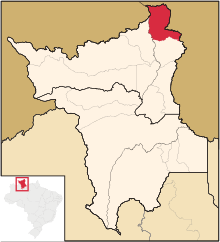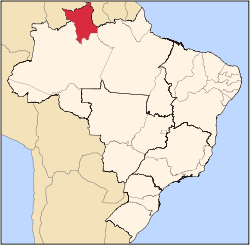Uiramutã
| Uiramutã | |||
|---|---|---|---|
| Municipality | |||
| Município de Uiramutã | |||
|
Marker on the Brasil-Venezuela-Guiana border, Monte Guyana | |||
| |||
 Location of Uiramutã in the State of Roraima | |||
| Coordinates: 04°35′45″N 60°10′04″W / 4.59583°N 60.16778°WCoordinates: 04°35′45″N 60°10′04″W / 4.59583°N 60.16778°W | |||
| Country |
| ||
| Region | North | ||
| State |
| ||
| Founded | October 17, 1995 | ||
| Government | |||
| • Mayor | Florany Mota (PT) | ||
| Area | |||
| • Total | 8,066 km2 (3,114 sq mi) | ||
| Elevation | 804 m (2,638 ft) | ||
| Population (2014) | |||
| • Total | 9,309 | ||
| • Density | 0.87/km2 (2.3/sq mi) | ||
| [1] | |||
| Time zone | UTC-4 | ||
| HDI (2000) | 0.542 – medium[2] | ||
Uiramutã is a municipality located in the northeast of the state of Roraima in Brazil. Its population is 9,309 (as of 2014) and its area is 8,066 km². It is the northernmost city in Brazil, with Monte Caburaí being the northernmost point. West of this mountain, there is also the Monte Roraima, the tallest mountain in Roraima and in Guyana, located in the triple frontier of Brazil, Guyana and Venezuela. Still, Uiramutã holds the title of the northernmost urban seat of a municipality in Brazil. Its counterparts in the South, West and East are respectively Chuí, state of Rio Grande do Sul; Mâncio Lima, Acre; and João Pessoa, Paraíba.
The municipality is located entirely inside the Raposa Serra do Sol Indian Reservation. Because of this, its economic activities are limited, and, as a result, Uiramutã is also noted for being the Brazilian municipality that depends the most on government funds: 80% of its income is provided by the public administration, including social insurance and welfare programs such as the Bolsa Família.[3]
References
- ↑ 2008 IBGE statistics
- ↑ - UNDP
- ↑ Patu, Gustavo (19 December 2013). "Em Uiramutã, no extremo norte do país, governo responde por 80% da economia". Folha de S. Paulo (in Portuguese). Grupo Folha. Retrieved 19 December 2013.
| |||||||||||||||||||||||||


